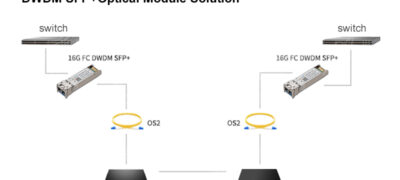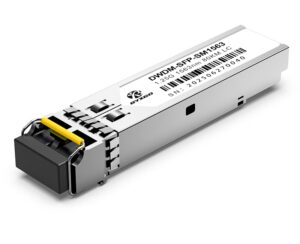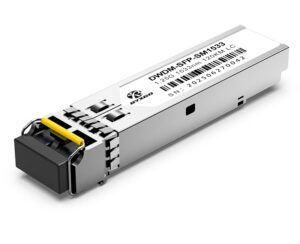Are you struggling with expanding network needs, yet don’t have enough fiber in place? If you can envision transmitting dozens of 1G signals across a single fiber strand, thereby significantly increasing capacity and not needing to spend the money to install additional fiber, you’re going to want to learn more about the cost-effective 1G DWDM SFP that expands access to dense wavelength division multiplexing. This advanced technology shifts multiple channels into a narrower optical wavelength envelope, thus enhancing reach gratification, minimizing fiber usage, and allowing for high-density and long-distance deployments, which are essential in the backbone and metro networks. The guide will examine the basic tenets of a 1G DWDM SFP module, product choices, and expanding your deployment practices in order to use the 1G DWDM SFP module as an effective way to increase your network growth in a cost-effective and scalable manner.

1G DWDM SFP Product Lineup: Discover the Best Solution for Your Network
The 1G DWDM SFP lineup provides a vast choice of wavelengths that accommodate the many variations of its application in a high-density, long-distance network. With the ITU-T channels covering from 191.3 THz (approx. 1563 nm) to 196.1 THz (approx. 1533 nm), wavelengths are offered to provide for every possible wavelength selection to optimize channel spacing.
In addition, the DWDM SFPs are universally compatible with both major vendors’ switches and routers, and go through a rigorous quality control process to make sure they are stable and work reliably under all conditions.
The featured models are:
- 1G DWDM SFP 191.3 THz (1563.86 nm)–specified for backbone links that carry high transmission requirements.
- 1G DWDM SFP 193.1 THz (1552.52 nm)–very popular for metro networks that take advantage of both reach and bandwidth.
- 1G DWDM SFP 196.1 THz (1533.47 nm)–engineered for long-haul applications where performance must maintain signal integrity.
In addition, each module supports a hot-pluggable installation option and includes a Diagnostic Monitoring Interface (DMI) to provide near-instant feedback for monitoring performance, etc.
This product line creates a class of products to give every network planner the ability to really scale their network and future-proof their networks in a form factor that is flexible and economically viable with the DWDM transceiver models offered.
Please refer to the product catalog for specification and product comparisons, giving you the ability to narrow down your choices for 1G DWDM SFP products to meet your exact network needs.

BYXGD-1.25Gb-DWDM-SFP-1563nm-80KM-LC: This 1.25 G DWDM SFP module offers 80 km transmission on a single-mode fiber in the C band. It has a DFB laser transmitting 0 to 5 dBm and a PIN photodiode with a sensitivity of ≤ -24 dBm. It has an extinction ratio of 9 dB and uses an LC connector for easy network adaptation.

BYXGD-1.25Gb-DWDM-SFP-1533nm-120KM-LC: This DWDM SFP transceiver module transmits distances of up to 120 km over single-mode fiber in the C-band. It includes a 1-5 dBm DFB laser and ≤ -31 dBm sensitivity APD photodiode. It has an extinction ratio of 9 dB and employs an LC connector for easy network deployment.
Why Choose 1G DWDM SFP? What It Brings to Your Network
1G DWDM SFP modules use Dense Wavelength Division Multiplexing (DWDM) to simultaneously transmit multiple 1G signals over a single fiber. Think of a densely packed highway where dozens of lanes (wavelengths) of cars (data streams) are traveling independently of one another without collision, thus maximizing the capacity of the fiber.
DWDM is based on the ITU-T wavelength grids that allocate channels closely together, often just 0.8 nm apart. With this allocation, networks can multiply the bandwidths significantly, and transmissions can be extended to beyond traditional distances, sometimes further than 80 km without regeneration.
DWDM technology delivers both high bandwidth and distance capabilities as well as significantly reducing fiber infrastructure requirements. This makes 1G DWDM SFP modules ideal for metro and backbone network applications where both capacity and distance are critical.
In addition to fiber saving capability, DWDM facilitates more scalability and flexibility to support expanded growth of future networks without the expense of physical upgrades.
DWDM Technology Benefits
For a more detailed understanding of DWDM technology and other possibilities, visit the DWDM vs WDM detailing the architecture and benefits.
In closing, 1G DWDM SFP modules allow networks to achieve great data throughput distances while optimizing fiber utilization while at the same time enabling a robust and scalable communications infrastructure!
In-Depth 1G DWDM SFP Analysis
When selecting the right 1G DWDM SFP module to integrate into a network, it is important to understand some important specifications and how they contrast with traditional 1G SFP transceivers. DWDM technology allows for multiple closely spaced wavelengths to be utilized over a single fiber optic line, utilizing the ITU-T defined channels, easily allowing for additional bandwidth and longer distances to be utilized.
Some of the main parameters to consider when selecting a 1G DWDM optical transceiver are the exact wavelength that will be selected based on the ITU-T grid, typically in the range of 191.3 THz to 196.1 THz. Selecting the precise channel allows for operations at either end of the transceiver to prevent interference and reduce the signal-to-noise ratio in the transmission of data. The optical power budget decides how far a signal can be transmitted or received before the signal quality deteriorates. Amplification along the wavelength would typically allow for a distance up to 80 km to be a safe range in achieving the budget.
Another critical aspect of 1G DWDM transceivers is inclusivity; optoelectrical transceivers should share compatibility across the entire network and fiber infrastructure, so users can all utilize the 1G DWDM SFP without any issues.
The table below provides a comprehensive comparison of the 1G DWDM SFP with standard 1G SFP modules:
Feature Comparison Table
| Feature | 1G DWDM SFP | Traditional 1G SFP |
| Fiber Usage | Multiple wavelengths on single fiber | One wavelength per fiber |
| Module Variety | Supports ITU-T channels from 191.3 to 196.1 THz | Typically single fixed wavelength (1310 nm or 1550 nm) |
| Installation Complexity | Higher – Requires precise wavelength coordination and multiplexing | Lower – Plug-and-play with standard fiber |
| Cost | Higher upfront due to multiplexing and precision | Lower initial cost but higher fiber usage |
| Typical Applications | Long-haul metro, backbone networks requiring high channel density | Shorter, low-density point-to-point links |
Selecting the right wavelength matching greatly reduces potential channel crosstalk and ensures the reliability of the network, making this step particularly important in the DWDM system design process.
In addition to discussing the actual specifications and requirements to help identify the correct balance between complexity, costs, and performance when adding 1G DWDM SFP modules to scalable and high-density situations.
Troubleshooting 1G DWDM SFP modules: Some common issues and resolution
The 1G DWDM SFP modules can sometimes exhibit issues due to their deployment in dense wavelength environments. One issue with any DWDM system is the potential for wavelength channel conflict when two channels are operating at chosen wavelengths that overlap, creating interference between the two signals. You can imagine how it would sound if various radio stations were on the same frequency; in other words, the two channels would be playing simultaneously at the specific frequency and making it difficult to discern what you were hearing clearly.
Channel crosstalk – Channel crosstalk occurs when the two channels interfere with each other, contributing to decreased signal quality. The source of the crosstalk is usually insufficient channel separation for good signal filtering. Regardless, separating channels is the only way to eliminate crosstalk.
Channel mismatch – Another issue can occur if the transmitter module and receiver module are on different wavelengths, to which no ITU-T standards can be applied in this case. This would prevent the two modules from communicating.
For any troubleshooting methodology(Click here learn more about troubleshooting), the decision is often based on systematic evaluation and confirmation. Begin your troubleshooting with CLI commands such as:
show interfaces transceiver detail
show interfaces optical
These commands will assist in consistently monitoring Tx/Rx power levels for accuracy, wavelength accuracy, and the status of the module(s).
Quickly identify potential faults by watching for atypical optical power readings, as well as any unexpected wavelength condition reports.
Routine maintenance should include cleaning the connectors, confirming the integrity of the fiber, and verifying the correct EDFA/DP/Transceiver is installed.
Utilizing these practices will effectively address the majority of common 1G DWDM SFP issues without delay and help to ensure reliable network operation.
1G DWDM SFP Enabling Efficient Metro Backbone Infrastructure Expansion
A metropolitan service provider had maxed out their data traffic needs, but their available data space would only allow them to grow bandwidth by four connections of 1 Gbps each through the existing fiber infrastructure at the cost of new fiber. As a result, they quickly leveraged available space by implementing 1G DWDM SFP modules and rapidly expanded bandwidth through existing fiber infrastructure.
The service provider utilized DWDM technology to multiplex multiple 1G channels onto one fiber at a staggering 65% reduction of fiber usage compared to the previous deployment. In addition to the fiber/material savings, the project saved the service provider—and more importantly, their customer—nearly a full month and a half of labor compared to the conventional deployment of fiber infrastructure.
As a result of these enhancements, it drastically increased the speed of deployment for fiber and 1G DWDM SFP modules, lowering project timelines by several weeks. Each upgrade added abundance to their network capacity while preserving service to end users or customers and enhanced the customer experience through a reduction in expected service downtime.
This is an example of how the 1G DWDM SFP modules allowed service providers to expand their transportation capacity significantly with growth potential through scalable modules without sacrificing cost, time, or utilizing too much of their existing infrastructure. All of us and our daily network depend on these types of strategies!
Frequently Asked Questions
1G DWDM modules are capable of multiplexing multiple wavelengths over a single fiber pair, enhancing capacity and reach. BiDi uses paired wavelengths to provide a bidirectional data stream over a single fiber, generally over a shorter distance.
Distances are typically up to 80 km or more based on the power budget, quality of the fiber, and whether amplification is used.
Careful matching to ITU-T channels avoids possible problems with channel interference while ensuring reliable, long-haul transmissions.
Mostly yes, but it is always a good idea to check compatibility and firmware versions to be sure.
Checking and cleaning the fiber connectors regularly, checking the transceiver diagnostics, and checking the optical power level will maximize performance.
Contact Us For The Best Solution
1G DWDM SFP modules can maximize bandwidth scaling, as well as the efficiency of the existing fiber network and ensure successful long-haul transmissions that are so important to both backbone networks and metro networks in particular. These scalable solutions also offer a great deal of future-proofing for your infrastructure for many years ahead while bringing down costs.
Explore the full range of 1G DWDM SFP products to meet the unique demands of your network. If you want to learn more about the best deployment and overall performance, a tech support contact can teach you how to do the best deployments of your mesh system as well.
